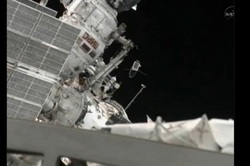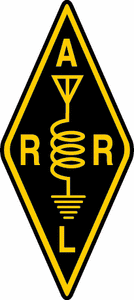 August 4, 2011 John E. Ross, KD8IDJ, Editor
| ||||||||||
+ Available on ARRL Audio News + Amateur Radio in Space: After Delays, ARISSat-1 Deployed from ISS
Amateur Radio has a new satellite! Despite concerns that led to an almost four hour delay in deployment from the International Space Station, ARISSat-1/KEDR is in operation. According to reports flowing in from around the world, both the transponder and telemetry are working. Cosmonauts Sergei Volkov, RU3DIS, and Alexander Samokutyaev, successfully deployed Amateur Radio's newest satellite: ARISSat-1/KEDR. The deployment -- originally scheduled to occur at 1457 UTC on Wednesday, August 3 -- was delayed due to antenna concerns. Read more here. + Amateur Radio in Space: Hams Report ARISSat-1's Linear Transponder Is Working After its eventful deployment yesterday, ARISSsat-1 is definitely working. Hams from all over the world have reported hearing the voice, CW and SSTV transmissions. Despite concerns that the UHF antenna was either missing or damaged, the linear transponder is working and some people are already making contacts with it. The August 3 deployment was delayed nearly four hours after cosmonauts Sergei Volkov, RU3DIS, and Alexander Samokutyaev, expressed concerns that only one antenna -- the VHF antenna -- was visible.
"I was able to hear myself with as little as 1 W on the 0425 UTC pass," AMSAT Vice President for Operations Drew Glasbrenner, KO4MA, wrote on the AMSAT e-mail reflector. "Antennas are a M2 CP42 on RHCP up, and a 10 element horizontal Yagi down. ARISSat-1 sounded very good, and cycled on and off with the telemetry. I also managed to grab two frames of telemetry right after AOS." Glasbrenner posted a video of his transponder test. Calling it a "very good first day," ARISSat-1/KEDR Project Manager Gould Smith, WA4SXM, said that hams are submitting SSTV images to ARISS SSTV Gallery, and BPSK-1000 telemetry and experiment data is coming into the telemetry server. "ARISSat-1/KEDR continues to work well with good reports coming in from around the world," he said. "The satellite is warmer than we expected, so we will continue to monitor this." The 435 MHz/145 MHz linear transponder operates in Mode U/v (70 cm up, 2 meters down). It is a 16 kHz wide inverting passband, and the convention is to transmit LSB on the 435 MHz uplink and receive USB on the 145 MHz downlink. + Amateur Radio in Space: ARISS Team Excited by New Proposal Process
Earlier this year, the education office at NASA's Johnson Space Center (JSC) sent a message to more than 18,000 US educators, describing the Amateur Radio on the International Space Station (ARISS) program. This kicked off the first step in a new process used by the ARISS team in selecting US schools for ARISS educational events, such as an Amateur Radio contact between the ISS and the classroom. Early last fall, staff from JSC's Teaching From Space program approached ARISS leaders, looking to revise how they work with schools in order to greatly increase the number of educators who know about ARISS.
According to ARRL ARISS Program Manager Rosalie White, K1STO, the ARISS team has worked steadily for the past six months on an end-to-end transition for the new proposal process. The work began last October with ARRL Education Services Manager Debra Johnson, K1DMJ, hosting a meeting at ARRL Headquarters for representatives from NASA, ARRL and AMSAT. In May, White and four NASA and AMSAT team members gathered in Maryland for a two day meeting to hammer out the final details. Read more here. + ARRL Recognizes: ARRL Board Names Angel Santana, WP3GW, Winner of Silver Antenna Award
Angel Santana, WP3GW, has been named the winner of the 2011 Philip J. McGan Memorial Silver Antenna Award for his volunteer public relations work on behalf of Amateur Radio. Santana was recognized for his work and recommended for the award by the ARRL Public Relations Committee; the ARRL Board of Directors conveyed the award at their 2011 Second Meeting last month. "It came as a surprise when ARRL Southeastern Director Greg Sarratt, W4OZK, sent me the notification about winning the 2011 Philip J. McGan Award," Santana said. "I had about two hours of shock before landing again to Earth!" ARRL Media and Public relations Manager Allen Pitts, W1AGP, called Santana a "sparkplug for a major surge of good publicity" in Puerto Rico. Read more here. + Investigation by ARRL OOs, Researchers Leads to Resolution of 60 Meter Interference Collaboration between ARRL Official Observers and researchers at Rutgers University has resulted in a change of operating frequency of coastal HF radars, eliminating interference to amateur stations using two frequencies in the 60 meter (5 MHz) band.
In July 2003, radio amateurs in the US received secondary privileges on 60 meters. Its strict guidelines -- no CW, operation just on five distinct channels using USB, a maximum effective radiated power of 50 W and only open to General, Advanced and Amateur Extra class licensees -- have prevented it from being popular. At first, amateurs interested in operating on 60 meters had to make modifications to the radios in use at the time. But now, more rigs are available that are designed to operate on 60 meters directly, or with a simple manipulation of menus. Over time, radio amateurs heard various signals on the channels; users assumed these signals were those of government users and protected as such. Normally, advice to amateurs is to "use it or lose it" in regard to band usage, but on 60 meters, the watchword seemed to be "misuse" the band and lose it. So amateurs were cautious and compliant and when the band was made available to radio amateurs, users reported that everyone on the band was friendly and courteous, with at least one amateur reporting "that it was the way all the other bands used to be." But recently, with more users and people monitoring and using the band, amateurs began hearing more Coastal Ocean Dynamics Applications Radar (CODAR) signals on the channels. CODAR is a form of HF radar used by a number of institutions to research and study ocean currents and waves. Amateurs frequently reported CODAR sounds as that "repetitive loud swishing sound" on the band. Read more here. ARRL in Action: What Have We Been Up to Lately?
This feature is a concise monthly update of some of the things that the ARRL is doing on behalf of its members. This installment -- which covers the month of July -- takes a look at the 2011 Second Meeting of the ARRL Board of Directors, the Republic of South Sudan -- the newest DXCC entity, the latest equipment and resource grants awarded to schools, the League's request to the FCC to keep open a proceeding regarding 2300 MHz, reports from the Official Observer Desk and more. Read more here. Solar Update
Tad "The Sun in my disgrace" Cook, K7RA, reports: Solar activity increased markedly this week, with the sunspot number rising to 130 on August 1, the highest since a reading of 131 on April 14, 2011. The average daily sunspot number for this week rose nearly 54 points to 99.3. But the big news is a couple of coronal mass ejections hurtling clouds of energy toward Earth, which should upset geomagnetic conditions from their recent quiet. The CMEs came from sunspot group 1263, which is quite large and centrally located on the solar disc. The latest forecast has the planetary A index for August 4-11 at 5, 25, 20, 25, 20, 12, 5 and 8. The predicted solar flux for August 4-5 is 120; August 6-10 is 115, 110 for August 11, and 100 on August 12-16. Geophysical Institute Prague predicts active conditions on August 5-7, unsettled to active August 8, quiet to unsettled August 9 and quiet conditions August 10-11. Look for more information on the ARRL website on Friday, August 5. For more information concerning radio propagation, visit the ARRL Technical Information Service Propagation page. This week's "Tad Cookism" is brought to you by Soundgarden's Black Hole Sun. + ARRL Recognizes: Jerry Clement, VE6AB , Wins July QST Cover Plaque Award
The winner of the QST Cover Plaque Award for July is Jerry Clement, VE6AB , for his article "Gain Twist 75 Meter Mobile Monobander. " Congratulations Jerry! The QST Cover Plaque award -- given to the author or authors of the best article in each issue -- is determined by a vote of ARRL members on the QST Cover Plaque Poll Web page . Cast a ballot for your favorite article in the August issue today. This Week on the Radio This week:
Next week:
All dates, unless otherwise stated, are UTC. See the ARRL Contest Branch page, the ARRL Contest Update and the WA7BNM Contest Calendar for more information. Looking for a Special Event station? Be sure to check out the ARRL Special Event Stations Web page. Upcoming ARRL Section, State and Division Conventions and Events
To find a convention or hamfest near you, click here. ARRL -- Your One-Stop Resource for Amateur Radio News and Information Join or Renew Today! ARRL membership includes QST, Amateur Radio's most popular and informative journal, delivered to your mailbox each month. Subscribe to NCJ -- the National Contest Journal. Published bi-monthly, features articles by top contesters, letters, hints, statistics, scores, NA Sprint and QSO Parties. Subscribe to QEX -- A Forum for Communications Experimenters. Published bi-monthly, features technical articles, construction projects, columns and other items of interest to radio amateurs and communications professionals. Free of charge to ARRL members: Subscribe to the ARES E-Letter (monthly public service and emergency communications news), the ARRL Contest Update (bi-weekly contest newsletter), Division and Section news alerts -- and much more! Find us on Facebook. Follow us on Twitter. ARRL offers a wide array of products to enhance your enjoyment of Amateur Radio Donate to the fund of your choice -- support programs not funded by member dues! Click here to advertise in this newsletter. | ||||||||||

















